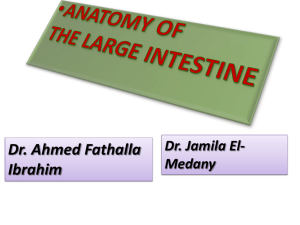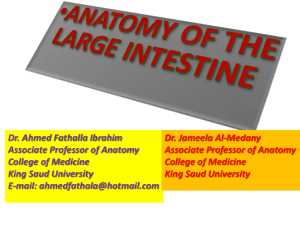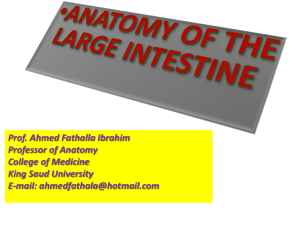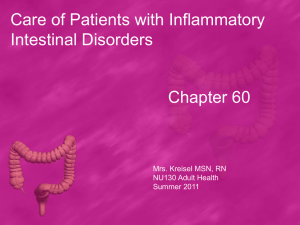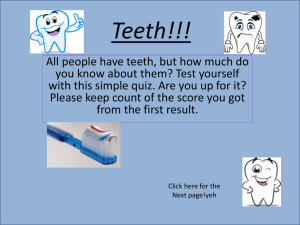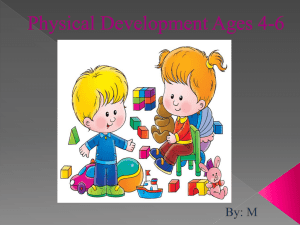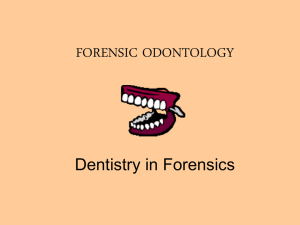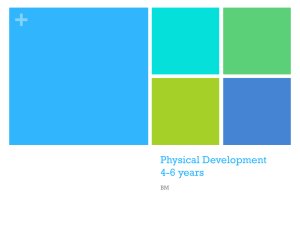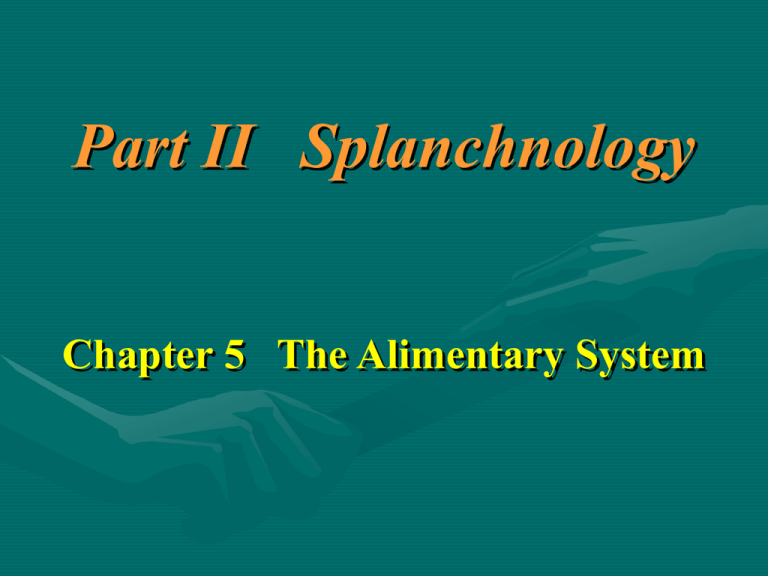
Part II Splanchnology
Chapter 5 The Alimentary System
Ⅰ. General Description:
* Constituents: 2 parts
Alimentary canal:
the mouth,
the pharynx,
the esophagus, the stomach,
the small intestines:
the duodenum, the jejunum,
the ileum
the large intestines:
the cecum and appendix,
the colon, the rectum,
the anal canal
Digestive glands:
the salivary glands:
the parotid gland
the submandibular gland
the sublingual gland
the liver,
the pancreas
* Functions:
ingest foods,
secrete enzymes,
absorb nutrients
eliminate unused residues
Ⅱ.The Mouth:
* 2 parts: oral vestibular, oral cavity proper.
* walls: oral lips, cheeks, palate, tongue.
isthmus of fauces
* contents: teeth, tongue.
* palate:
hart palate
soft palate
palatine velum
palatoglossal arch
palatopharyngeal arch
palatine tonsil
* isthmus of fauces:
uvula
free margin of palatine velum
palatoglossal arch
root of tongue.
* The teeth
deciduous teeth
permanent teeth
The structure:
crown
root
neck of teeth
dentine
enamel
cement
periodontal membrane
dental cavity, root canal
apical foramen
dental pulp
deciduous teeth: 20
2 pairs of incisors
1 pair of canine tooth
2 pairs of molars
permanent teeth: 28-32
2 pairs of incisors
1 pair of canine tooth
2 pairs of premolars
3 pairs of molars
(wisdom tooth)
• The tongue
3 parts--- root, apex and body
2 surfaces---dorsum and inferior surface
Dorsum: V-shaped terminal sulcus
4 kinds of papillae---Filiform papillae
Fungiform papillae
Foliate papillae
Vallate papillae
lingual tonsil
Inferior surface of tongue:
the Frenulum of tongue
the Sublingual caruncle
the Sublingual folds
Structures:
mucosa,
muscles of the tongue
Ⅲ. The pharynx:
• Position:
in front of the 1~6th cervical vertebrae
• Parts: Nasopharynx
Oropharynx
Laryngopharynx
• Features and structures:
nasal part---pharyngeal opening of auditory tube
tubal torus
pharyngeal recess
oral part--palatine tonsil,
tubal tonsil
laryngeal part---piriform recess
• Communication of pharynx:
anteriorly: ---choanae---nasal cavity
---isthmus of fauces---oral cavity
---aperture of larynx---laryngeal cavity
inferiorly: ---esophagus
Laterally:---pharyngeal opening of auditory tube---tympanic cavity
Ⅳ.The Esophagus:
• 3 parts: cervical, thoracic and
abdominal parts
• 3 constrictions:
1st---at its commencement, 15cm
from the incisor teeth
2nd---where is crossed by the left
principal bronchus anteriorly,
25cm from the incisor teeth
3rd---where it passes through the
diaphragm, 40cm from the
incisor teeth
• Structures:
upper part: skeleton m.
middle part: skeleton m.and smooth m.
lower part: smooth m.
• position
• The Salivary glands:
The Parotid gland
The Sublingual gland
The Submandibular gland
The Name,
Positions,
Opening of its ducts
Ⅴ.The stomach :
The shape and parts
2 openings: cardia, pylorus
2 surfaces: anterior and posterior
2 curvatures: greater curvature
lesser curvature
angular incisure
4 parts: the cardiac part
the fundus of stomach
the body of stomach
the pyloric part
pyloric antrum
pyloric canal
The position and relations
--- the position:
Its between the end of the
esophagus and the beginning
of the small intestine. It lies in
the epigastric, umbilical and
left hypochondriac regions of
abdomen.
cardiac orifice– at left side
of 11th thoracic vertebra
pyloric orifice– at right side
of 1st lumbar vertebra
--- the relations:
anteriorly---
left costal margin
diaphragm
left pleura
the base of the left lung
the left pleural cavity
the pericardium
left and quadrate lobes of the liver
the anterior abdominal wall
transverse colon
posteriorly--the diaphragm
the spleen
the left suprarenal gland
the upper part of the
left kidney
the splenic artery
the left colic flexure
the anterior surface of the pancreas
the upper layer of the transverse mesocolon
“ stomach bed ”
omental bursa
The structures of the wall of stomach: 4 layers
--- mucosa:
mucous folds
longitudinal mucous folds
pyloric valve
--- submucosa
--- muscular layers:
inner oblique layer
intermediate circular layer
pyloric sphincter
outer longitudinal layer
--- serous membrane
Ⅵ.The duodenum
C-shaped
4 parts---superior part
descending part
horizontal part
ascending part
Structure--Descending part has
longitudinal fold
major duodenal papilla
Position and relationshap--It encloses the head of the
pancreas; A retroperitoneal organ;
Most part of it attached the posterior abdominal wall.
Ⅶ.
Jejunum
and
Ileum:
Upper 2/5
Lower 3/5
Wider in diameter and wall is thicker;
Thiner in diameter and wallis thinner
Color is redder and has more vascular
Color is not redder than jejunum and
has lesser vascular
The circular mucosal folds are larger and
more
The circular mucosal folds are shorter
and few
Only solitary lymphatic follicles
Solitary and aggregated lymphatic
follicles
Ⅷ. Large intestine:
Parts--- colon
cecum
rectum
anal canal
structures --except rectum anal canal and appendix
3 colic bands
haustra of colon
epiploic appendices
The cecum and vermiform appendix :
position: in the right iliac fossa, above the
lateral half of the inguinal ligament and
below the ileocecal valves.
structure: ileocecal valves
opening of the vermiform appendix
Vermiform:
shape: worm shaped tube, 2—20 cm in length, about 8.3cm in
average
Position: right iliac or inguinal region ,
spings from the posteromedial wall of the cecum.
common positions of the tip:
retrocecally,
inferior to the cecum,
behind or front of ileum,
into the lesser pelvis
Surface projection of the root of
vermiform appendix--McBurney’s point
McBurney’s point
At the junction of the meddle
and lateral thirds of a line that
joints the right anterior superior
iliac spine and the umbilicus.
Colon:
4 parts---ascending colon
transverse colon
descending colon
sigmoid colon
The
rectum:
position--- It lies in the posterior part of less pelvis,
anterior to the sacrum and coccyx.
shape--- 2 flexures:
Sacral flexure
Perineal flexure
Ampulla of rectum
structures--3 transverse folds of rectum
The Anal Canal:
position:
structures:
mucous membrane--anal columns
anal valves
anal sinuses
dentate line
anal pecten (hemorrhoidal ring )
white line
submucosa--muscular layer--sphincter ani internus
sphincter ani externus

